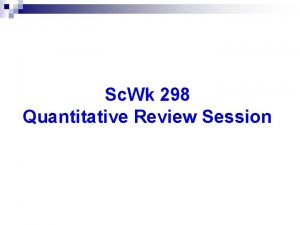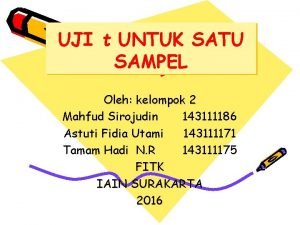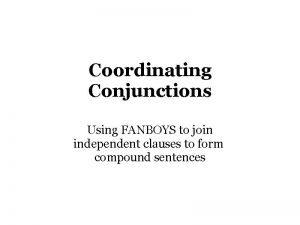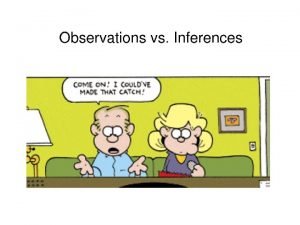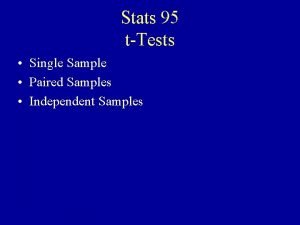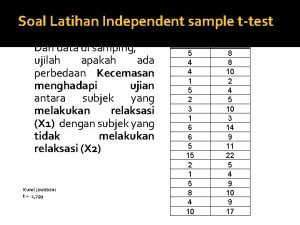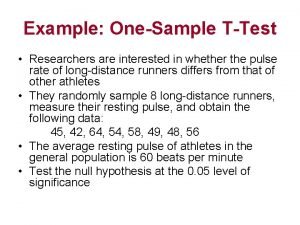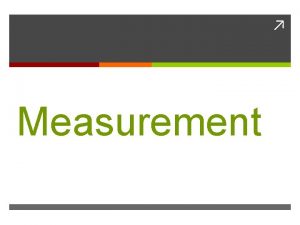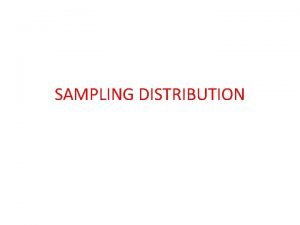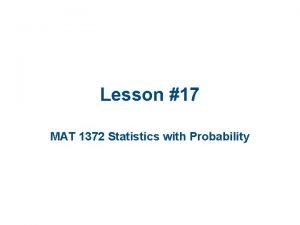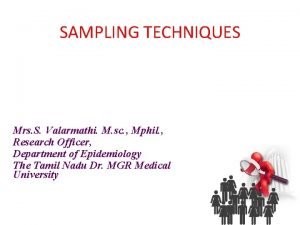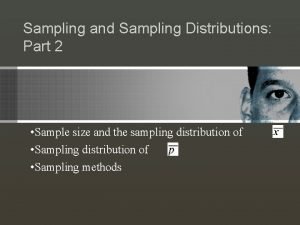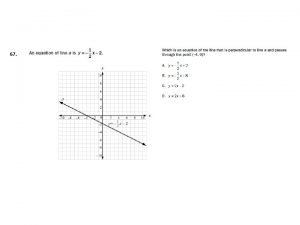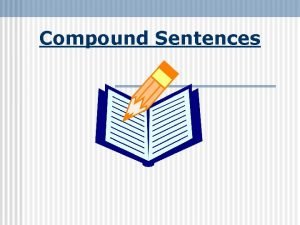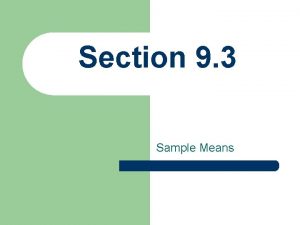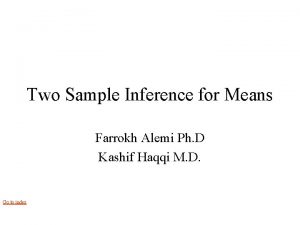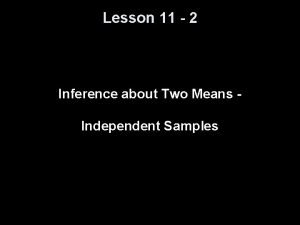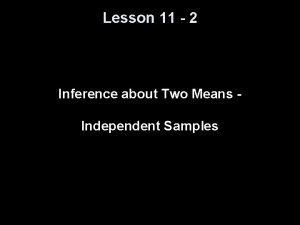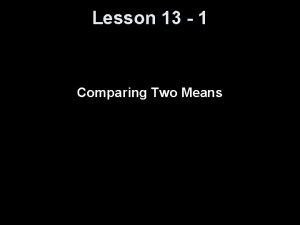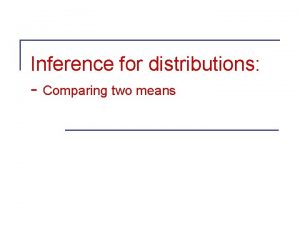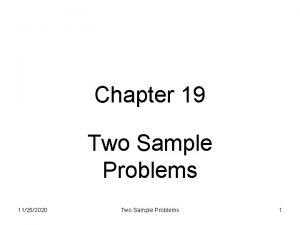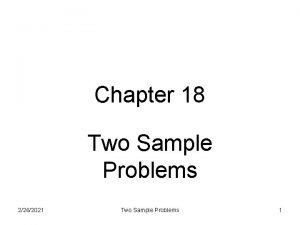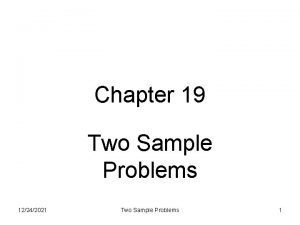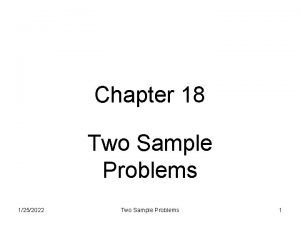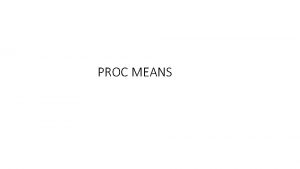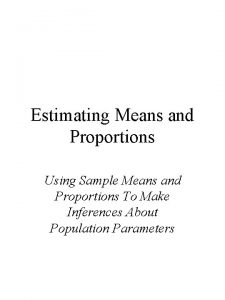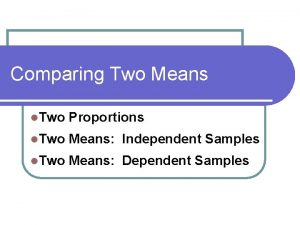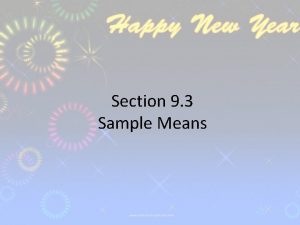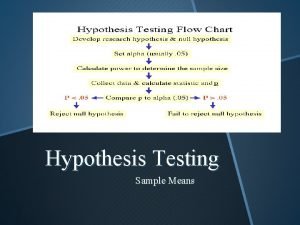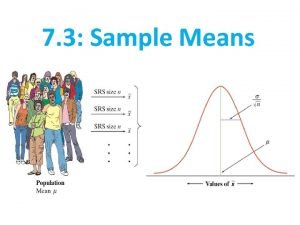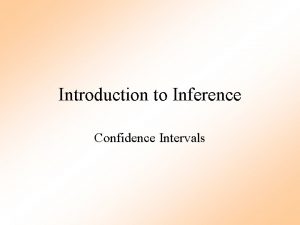Inference for Two Independent Sample Means Inference for
























- Slides: 24

Inference for Two Independent Sample Means Inference for Two Samples 1

Introduction to Statistical Inference Methods � � Statistical Inference: Drawing conclusions about a population from sample data. Methods Ø Point Estimation– Using a sample statistic to estimate a parameter Ø Confidence Intervals – supplements an estimate of a parameter with an indication of its variability Ø Hypothesis Tests - assesses evidence for a claim about a parameter by comparing it with observed data Parameter Measure Statistic Mean of a single population Proportion of a single population Mean difference of two dependent populations (MP) Difference in means of two independent populations Difference in proportions of two populations Variance of a single population Standard deviation of a single population S

Independent Samples � Two samples are independent when the method of sample selection is such that those individuals selected for sample 1 do not have any relationship to those individuals selected for sample 2. � The samples are unrelated, uncorrelated. 3

Independent Samples assumptions: � With one sample tests, we compare a single sample mean to a known population mean (a value we believe to be true in the null hypothesis). � Now both population means, m 1 & m 2 are unknown. � We may be interested in the difference in treatments on the two groups as a whole. � Our parameter of interest would now be m 1 -m 2

Sampling Distribution of the difference in means � Suppose we had two normally distributed populations: � Heights of males in the US: � Heights of females in the US: ◦ X 1 ~ N(69, 3. 2) ◦ X 2 ~ N(64, 2. 8) �I built two sampling distributions (n=10) in Minitab. 5

6

Difference Distribution � 7

Difference Distribution This histogram represents the distribution of male mean heights subtracted from the distribution of female heights. 8

Sampling distribution of the difference in means: Large Samples � 9

Looking at differences in means Ways to analyze the mean difference � Create a comparative boxplot. � Run a formal 2 sample HT for µ 1= µ 2 to see if there is a difference. � If you find a difference, calculate a CI to estimate it 10

Hypothesis Test of the difference in means: Test Statistic �

Sampling distribution of the difference in means: Small Samples � 12

Hypothesis Test of the difference in means: Test Statistic �

� The Hypothesis Test of the difference in means: Hypotheses Null is the “No change” Hypothesis ◦ H 0: m 1 - m 2 =0 OR (m 1 = m 2) � Alternative options: ◦ Two Tailed test �Ha: m 1 – m 2 ≠ 0 or (m 1 ≠ m 2) ◦ One Tailed test �Ha: m 1 – m 2 > 0 or (m 1 > m 2 ) �Ha: m 1 – m 2 < 0 or (m 1 < m 2 )


Degrees of Freedom? � Easiest to just use a “conservative estimate”: Min{n 1– 1, n 2– 1} � There is also more precise way of calculating 2 independent sample df, although you will most likely not want to deal with this by hand:

Two sample means hypothesis test � Suppose that a school district is interested in comparing standardized test scores for two high schools (East and West) having different curriculums. A sample of students is taken from both schools. The data is summarized as follows: n Mean S East HS 24 84 8. 78 West HS 26 78. 34 7. 553

Stating Hypotheses � It is unclear which school will achieve high scores. � The null states that the population means for the two groups are equal. � Consider a two-tailed hypothesis test H 0: m 1 – m 2 = 0 or m 1 = m 2 Ha: m 1 – m 2 ≠ 0 or m 1 ≠ m 2 � As � usual, we will state a = 0. 05. It does not matter which group we designate as group 1 or 2.

Check Conditions � Check your assumptions for t visually � Graph each sample to check conditions:

Test Statistic n Mean S East HS 24 84 8. 78 West HS 26 78. 34 7. 553

Critical Value � We need a T Critical value with: ◦ df=min {n 1 -1, n 2 -1) = min{24 -1, 26 -1} = 23 ◦ a = 0. 05 ◦ Two-Tailed � Table Value ◦ ± 2. 069 21

P-value � We need 2*P(t > 2. 437) � Estimating w/ table ◦ df=min {n 1 -1, n 2 -1)= min{24 -1, 26 -1} = 23 ◦ 2*(0. 01)<-p-val< 2*(0. 025) => 0. 02<-p-val< 0. 05 � By Technology: ◦ 0. 02296

Conclusion � Test � The Statistic is in Rejection Region p-value is 0. 023 < 0. 05, reject the null hypothesis � The difference between the two groups is “statistically significant. ” � This means there is a difference in the two curriculum 23

Estimating the difference: CI for m 1 - m 2 � Now that we have found a difference, let’s estimate it. � Construct a 95% CI for the difference in means � Recall n Mean S East HS 24 84 8. 78 West HS 26 78. 34 7. 553 df=min {n 1 -1, n 2 -1)= min{24 -1, 26 -2} = 23 the sample statistics: � Plugging in: � Interpret: ◦ We are 95% confident the true difference in means is captured by this interval 24
 Two independent sample t test spss
Two independent sample t test spss Z test two sample for means
Z test two sample for means Uji t satu sampel
Uji t satu sampel Fanboys connectors
Fanboys connectors Sample of observation and inference
Sample of observation and inference Observation and inference examples
Observation and inference examples Unpaired t test
Unpaired t test Contoh soal dan jawaban independent sample t test
Contoh soal dan jawaban independent sample t test Researchers are interested in whether or not
Researchers are interested in whether or not Quadrilateral pentagon hexagon octagon
Quadrilateral pentagon hexagon octagon Meta means and morphe means
Meta means and morphe means Meta means in metamorphism
Meta means in metamorphism Bio means life
Bio means life Bio means life logy means
Bio means life logy means How to solve sampling distribution of sample means
How to solve sampling distribution of sample means Construct the sampling distribution of the sample means
Construct the sampling distribution of the sample means Convenience sampling example
Convenience sampling example Typical case sampling adalah
Typical case sampling adalah Volunteer sample vs convenience sample
Volunteer sample vs convenience sample Multi-stage sampling example
Multi-stage sampling example Stratified sampling vs cluster sampling
Stratified sampling vs cluster sampling Ncsbn next generation nclex
Ncsbn next generation nclex Independent events statistics
Independent events statistics How to tell if two events are independent
How to tell if two events are independent Sentence with two independent clauses
Sentence with two independent clauses
